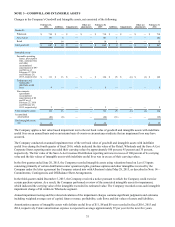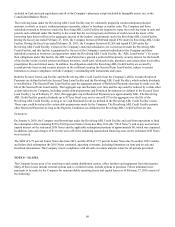Albertsons 2016 Annual Report Download - page 75
Download and view the complete annual report
Please find page 75 of the 2016 Albertsons annual report below. You can navigate through the pages in the report by either clicking on the pages listed below, or by using the keyword search tool below to find specific information within the annual report.
73
Recently Adopted Accounting Standards
In November 2015, the Financial Accounting Standards Board (“FASB”) issued authoritative guidance under accounting
standard update (“ASU”) 2015-17, Income Taxes (Topic 740): Balance Sheet Classification of Deferred Taxes. ASU 2015-17
requires all deferred income tax assets and liabilities to be classified as non-current in a classified balance sheet. The Company
adopted ASU 2015-17 in fiscal 2016 on a retrospective basis resulting in a $15 reduction of Deferred tax assets and Other
current liabilities within the Company's Consolidated Balance Sheets as of February 28, 2015.
In April 2015, the FASB issued authoritative guidance under ASU 2015-03, Interest—Imputation of Interest (Subtopic 835-30):
Simplifying the Presentation of Debt Issuance Costs. ASU 2015-03 requires debt issuance costs to be presented in the balance
sheet as a direct deduction from the carrying amount of the related debt obligation. The Company adopted ASU 2015-03 in
fiscal 2016 on a retrospective basis resulting in a $35 reduction of Other assets and Long-term debt within the Company's
Consolidated Balance Sheets as of February 28, 2015. Debt financing costs for the Company's revolving credit facility are
presented as a reduction of the related borrowings when a balance is drawn on the facility and as an asset within Other assets
when no balance is drawn on the facility.
Recently Issued Accounting Standards
In March 2016, the FASB issued authoritative guidance under ASU 2016-09, Compensation-Stock Compensation (Topic 718)
Improvements to Employee Share-Based Payment Accounting. ASU 2016-09 provides for simplification of several aspects of
the accounting for share-based payment transactions, including income tax consequences, classification of awards as either
equity or liabilities and classification on the statement of cash flows. The Company is required to adopt this new authoritative
guidance in the first quarter of fiscal 2018. The Company is currently evaluating the potential impact of adoption of this
standard on its consolidated financial statements.
In February 2016, the FASB issued authoritative guidance under ASU 2016-02, Leases (Topic 842). ASU 2016-02 provides
new comprehensive lease accounting guidance that supersedes existing lease guidance. Upon adoption of ASU 2016-02, the
Company will be required to recognize most leases on its balance sheet at the beginning of the earliest comparative period
presented with a corresponding adjustment to stockholders' equity. ASU 2016-02 requires the Company to capitalize most
current operating lease obligations as right-of-use assets based on the present value of future operating lease payments and to
recognize a corresponding liability. Criteria for distinguishing leases between finance and operating are substantially similar to
criteria for distinguishing between capital leases and operating leases in existing lease guidance. The Company is required to
adopt this new authoritative guidance in the first quarter of fiscal 2020. The Company is currently evaluating the potential
impact of adoption of this standard on its consolidated financial statements.
In January 2016, the FASB issued authoritative guidance under ASU 2016-01, Financial Instruments—Overall (Subtopic
825-10): Recognition and Measurement of Financial Assets and Financial Liabilities. ASU 2016-01 revises the classification,
measurement and disclosure of investments in equity securities. The Company is required to adopt this new authoritative
guidance in the first quarter of fiscal 2019. Due to the Company's current limited involvement in investments in equity
securities, the Company does not expect that this standard will have a material impact on its consolidated financial statements.
In May 2014, the FASB issued authoritative guidance under ASU 2014-09, Revenue from Contracts with Customers (Topic
606): Revenue from Contracts with Customers. ASU 2014-09 supersedes existing revenue recognition requirements and
provides a new comprehensive revenue recognition model that requires entities to recognize revenue to depict the transfer of
goods or services to a customer at an amount that reflects the consideration it expects to receive in exchange for those goods or
services. The new authoritative guidance will likely be adopted by the Company during the first quarter of fiscal 2019, as
permitted by ASU 2015-14, Revenue from Contracts with Customers (Topic 606): Deferral of the Effective Date. The adoption
will include updates as provided under ASU 2016-08, Revenue from Contracts with Customers (Topic 606): Principal versus
Agent Considerations (Reporting Revenue Gross versus Net). Adoption is allowed by either the full retrospective or modified
retrospective approach. The Company is currently evaluating which approach it will apply and the potential impact of the
adoption on its consolidated financial statements.
NOTE 2—BUSINESS ACQUISITIONS
The Consolidated Financial Statements reflect the final purchase accounting allocations of the acquisitions discussed below.
Pro forma information for the acquisitions discussed below are not presented since the results of operations of the acquired
businesses, both individually and in the aggregate, are not material to the Company’s Consolidated Financial Statements.
Recognized goodwill represents future economic benefits expected to arise from the Company’s presence in the retail market.
























